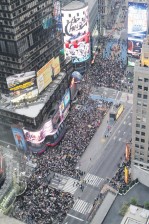Donations pour in for Wall Street protesters

SQUARING OFF Demonstrators affiliated with the Occupy Wall Street movement rally in New York’s Times Square. AP
NEW YORK—The month-old Occupy Wall Street movement is still growing, with nearly $300,000 in the bank and the satisfaction of drawing attention to what it calls the financial elite’s overly dominant influence on society.
From a few dozen people camping out in a small Manhattan park near the rising World Trade Center complex, the movement swelled to hundreds of thousands of people rallying around the world this weekend and numerous encampments springing up in cities large and small.
For the most part, the US protest action remained loosely organized and there were no specific demands, something Legba Carrefour, a participant in the Occupy DC protest, found comforting.
“When movements come up with specific demands, they cease to be movements and transform into political campaign rallies,” said Carrefour, who works as a coat check attendant despite holding a master’s degree in cultural studies.
“It’s compelling a lot of people to come out for their own reasons rather than the reasons that someone else has given to them,” he said.
Article continues after this advertisementStill, there is conflict. Some protesters eventually want the movement to rally around a goal, while others insist that isn’t the point
Article continues after this advertisement“We’re moving fast, without a hierarchical structure and lots of gears turning,” said Justin Strekal, a college student and political organizer who traveled from Cleveland to New York to help. “… Egos are clashing, but this is participatory democracy in a little park.”
Wall Street protesters are intent on hanging on to the momentum they gained from Saturday’s worldwide demonstrations, which drew hundreds of thousands of people, mostly in the United States and Europe.
They’re filling a cavernous space on Broadway a block from Wall Street with donated goods to help sustain their nearly monthlong occupation of the private park nearby.
Long-term occupation
They’ve amassed mounds of blankets, pillows, sleeping bags, cans of food, medical and hygienic supplies—even oddities like a box of knitting wool and 20 pairs of swimming goggles (to shield protesters from pepper-spray attacks). Supporters are shipping about 300 boxes a day, Strekal said.
The space was donated by the United Federation of Teachers, which has offices in the building.
Close to $300,000 in cash also has been donated, through the movement’s website and by people who give money in person at the park, said Bill Dobbs, a press liaison for Occupy Wall Street.
The movement has an account at Amalgamated Bank, which bills itself as “the only 100 percent union-owned bank in the United States.”
Strekal said the donated goods were being stored “for a long-term occupation.”
“We are unstoppable! Another world is possible!” Kara Segal and other volunteers chanted in the building lobby as they arrived to help unpack and sort items, preparing them to be rolled out to the park.
While on the streets, moments of madness occasionally erupt in the protest crowd—accompanied by whiffs of marijuana, grungy clothing and disarray—order prevails at the storage site.
It doubles as a sort of Occupy Wall Street central command post, with strategic meetings that are separate from the “general assembly” free-for-alls in the park.
Issue in US primary
The movement has become an issue in the Republican presidential primary race and beyond, with politicians from both parties under pressure to weigh in.
US President Barack Obama referred to the protests at Sunday’s dedication of a monument for Martin Luther King Jr., saying the civil rights leader “would want us to challenge the excesses of Wall Street without demonizing those who work there.”
More than 360 people were arrested across the United States in protests on Saturday, but many of the largest were in Europe, where those involved in long-running demonstrations against austerity measures declared common cause with the Occupy Wall Street movement.
In Rome, hundreds of rioters infiltrated a march by tens of thousands of demonstrators, causing what the mayor estimated was at least $1.4 million in damage to city property.
In London, more than 200 protesters awoke in the heart of London’s financial district on Monday for a third day of demonstrations.
They huddled with cups of tea in the cold autumn sunshine as bankers, lawyers and business people flooded into the area for the start of the working week.
Sitting on the steps of the cathedral near a big banner reading “Capitalism Is Crisis,” unemployed teacher Danielle Allen said the protesters would stay “as long as it takes” to get their message across.
Global conversation
The online conversation about the movement turned global over the weekend as protesters provided live Twitter updates, photos and videos from the dozens of demonstrations around the world.
Using cell phones and social media tools, demonstrators shared developments in their cities in real time Saturday for all the world to see.
Posting links on Twitter and Facebook, they uploaded photos and videos to YouTube and image-sharing sites like Bambuser and Yfrog.
In Spain, protesters uploaded live video from Madrid on Ustream, a video-sharing site.
Organizers in New York also used their Global Revolution channel on Livestream to deliver live video feeds of the protests in New York. Comments about the global protests from users around the world could be found on the channel, with links to videos and live streams of protests.
According to Trendrr, a social media analysis company, the number of posts about Occupy Wall Street on Twitter outside the United States grew to more than 25 percent of total posts on Friday, up from 15 percent during the same period the week before.
On Facebook, the overall audience has grown to more than 1.2 million in the past two weeks as hundreds of Facebook pages have been created around the country and the world. Dozens of global Facebook pages now focus on the protest, including Occupy Brazil, Occupy Berlin, Occupy Sydney and Occupy Tokyo. Reports from AP, AFP and New York Times News Service